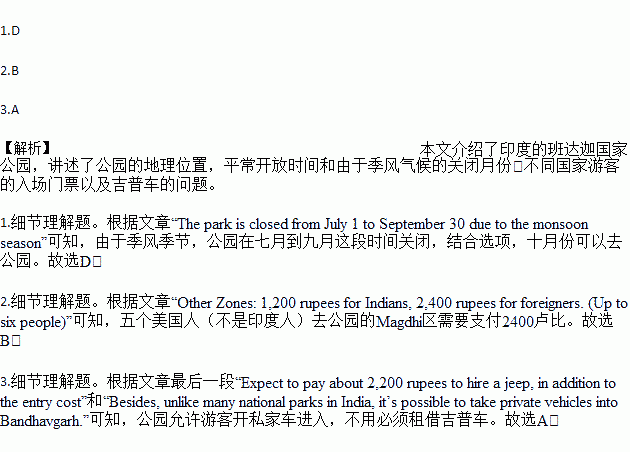题目内容
Bandhavgarh National Park in India is best known for its amazing setting, as well as having the highest concentration of tigers in India. In addition to tigers, there are also bears, deer, wolves, birds, etc.
Location: In Madhya Pradesh state, almost 200 kilometers northeast of Jabalpur. The nearest village is Tala, which is the access point of the park.
Opening Hours and Safari (游猎) Times
Safaris operate twice a day, starting at dawn until late morning, and mid afternoon until sunset. The best time to visit the park is early in the morning or after 7 p.m. to spot the animals. The park is closed from July 1 to September 30 due to the monsoon season (季风季节).
Bandhavgarh Zones
Bandhavgarh is divided into three main zones: Tala (the park’s best zone, with the most tigers), Magdhi (the second best zone to see tigers), and Khitauli (scenic and less visited, although tiger sightings do occur there; particularly good for birding).
Entry Fees and Charges for Jeep Safaris
Bandhavgarh has become expensive to visit in recent years. Entry fees have increased since October 2014. When going on a safari, separate fees must be paid for park entry and jeep hire. Entry tickets are priced per vehicle (up to six people). For 2015-16, park entry tickets cost as follows:
·Tala Zone: 2,400 rupees for Indians, 4,800 rupees for foreigners. (Up to six people)
·Other Zones: 1,200 rupees for Indians, 2,400 rupees for foreigners. (Up to six people)
Jeep Hire
Expect to pay about 2,200 rupees to hire a jeep, in addition to the entry cost. This can be done at the park entrance. All hotels can arrange jeep hire and tours, but at a higher rate. It’s much less trouble though. Besides, unlike many national parks in India, it’s possible to take private vehicles into Bandhavgarh.
1.When can you visit the park?
A. In July. B. In August.
C. In September. D. In October.
2.How much should five Americans pay for entry fees to visit Magdhi Zone?
A. 1,200 rupees. B. 2,400 rupees.
C. 4,800 rupees. D. 6,000 rupees.
3.Which of the following statements is TRUE about jeep hire in the park?
A. Tourists don’t have to hire jeeps.
B. Hiring jeeps from hotels costs less money.
C. Tourists can only hire a jeep from the park.
D. Jeep hire fees are included in the entry cost.
 快乐小博士巩固与提高系列答案
快乐小博士巩固与提高系列答案Nowhere is the place you never want to go. It’s not on any departure board, and though some people like to travel so far off the motherland that it looks like Nowhere, most wanderers ultimately long to get somewhere. Yet every now and then—if there’s nowhere else you can be and all other options have gone—going nowhere can prove the best adventure around.
Nowhere is entirely uncharted; you’ve never read a guidebook entry on it or followed others’ suggestions on a train ride through its suburbs. Few YouTube videos exist of it. Moreover, it’s free from the most dangerous kind of luggage, expectation. Knowing nothing of a place in advance opens us up to a high energy we seldom encounter while walking around Paris or Kyoto with a list of the 10 things we want—or, in embarrassing truth, feel we need—to see.
I’ll never forget a bright January morning when I landed in San Francisco from Santa Barbara, just in time to see my connecting flight to Osaka take off. I hurried to the nearest airline counter to ask for help, and was told that I would have to wait 24 hours, at my own expense, for the next day’s flight. An unanticipated delay is exactly what nobody wants on his schedule. The airline didn’t answer for fog-related delays, a gate agent declared, and no alternative flights were available.
Millbrae, California, the drive-through town that encircles San Francisco’s airport, was a mystery to me. With one of the world’s most beautiful cities only 40 minutes to the north, and the unofficial center of the world, Silicon Valley, 27 miles to the south, Millbrae is known mostly as a place to fly away from, at high speed.
It was a cloudless, warm afternoon as a shuttle bus deposited me in Millbrae. Locals were taking their dogs for walks along the bay while couples wandered hand in hand beside an expanse of blue that, in San Francisco, would have been crowded with people and official “attractions.” I checked in to my hotel and registered.
Suddenly I was enjoying a luxury I never allow myself, even on vacation: a whole day free. And as I made my way back to my hotel, lights began to come on in the hills of Millbrae, and I realized I had never seen a sight half so lovely in glamorous, industrial Osaka. Its neighbor Kyoto is attractive, but it attracts 50 million visitors a year.
Who knows if I’ll ever visit Millbrae again? But I’m confident that Nowhere will slip into my schedule many times more. No place, after all, is uninteresting to the interested eye. Nowhere is so far off the map that its smallest beauties are a discovery.
The Unexpected Joys of a Trip to Nowhere | |
Passage outline | Supporting details |
Introduction to Nowhere | ●Although many choose to travel beyond the 1., they actually hope to get somewhere. ●Getting nowhere can be the best adventure when we are2. out of options. |
3. of Nowhere | ●You don’t have to be 4. on a guidebook entry or others’ advice. ●With limited information of a place and little expectation, we will encounter a 5. high energy that doesn’t exist when visiting Paris or Kyoto. |
The author’s experience of getting nowhere | ●The airline wasn’t 6. for unexpected delays and there were no alternative flights available. ●He decided to visit the mysterious Millbrae,7. between San Francisco and Silicon Valley. ●He 8. to enjoy such a luxurious and free time in big cities before. |
Conclusion | ●Though 9. about whether to visit Millbrae again, Nowhere will be included in his schedule. ●Nowhere is entirely uncharted with its beauties to be 10.. |
暑假即将来临,你班同学讨论了假期计划,提出了不同看法。请根据提示写一篇有关讨论的英语短文,并谈谈你的看法。
优 点 | 缺 点 | |
待在家中 | 花费少、舒适方便 | 不能亲身了解外界 |
外出旅游 | 增长知识、开阔眼界 | 花费多、旅途不便 |
注意:1.短文写在答题卡上的指定区域,词数80—120(不含已写好部分)。
2.短文必须包括表中所列要点,可根据内容分段表述。
3.可适当增加细节,以使行文连贯。
The summer holiday is coming. Our class have had a discussion about what to do during the holiday.
____________________________________________________________________________________________
____________________________________________________________________________________________
____________________________________________________________________________________________
____________________________________________________________________________________________
____________________________________________________________________________________________
____________________________________________________________________________________________
_____________________________________________________________________

